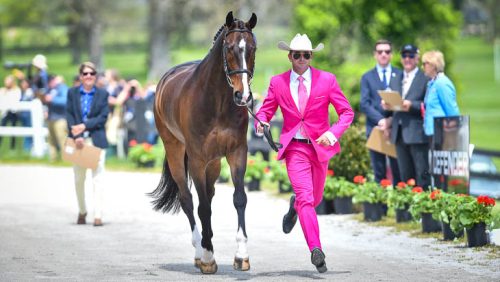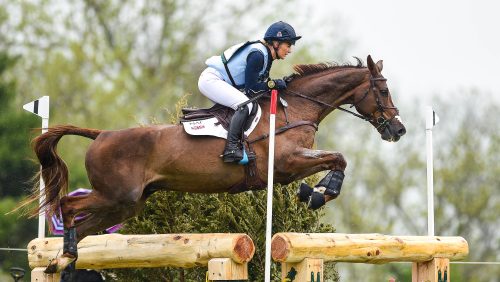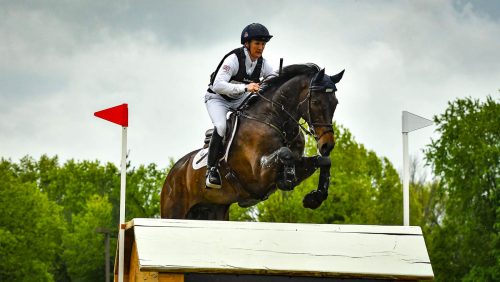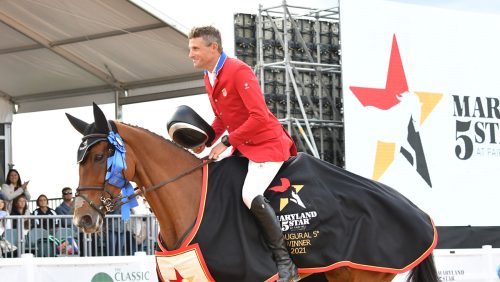Her official job title might be Director of Show Jumping for the U.S. Equestrian Federation, but those words just barely scratch the surface of Sally Lord Ike’s involvement in horse sports. And while she’s now responsible for making sure the top U.S. show jumping teams get where they need to go, her first love is eventing.
“I was always intrigued, and still am, by the producing of the horses, the training of the horses,” Ike said. “And that’s what I love about eventing–the challenge of being able to train a horse to do a dressage test, and then jump around cross-country, and then show jump. It was never about winning for me–it was always about how well they went. Was it better than they’d gone the last time? Did they learn?”
You’ll find her designing the show jumping course for the Fair Hill CCI*** (Md.), judging dressage at a horse trials you might be attending, or walking the course as technical delegate at an event. And hanging on the wall of her office at the USEF offices in Gladstone, N.J., are photos of her on Evening Mail, the horse with which she was non-traveling alternate for the 1968 Olympic eventing team.
“It tickles me sometimes that people don’t understand why she’s so successful at what she does now, but it’s because she did it all as a rider,” said Jim Wofford, who was on that 1968 Olympic team. “She was an Olympic-level athlete of her day, and I think that explains a lot of how her trips and teams run so smoothly–it’s because she’s been there and done it. She understands why certain things are important to riders, because they were important to her when she was a rider.”
And while she never got to experience the Olympics as a rider, one of Ike’s career highlights was watching the U.S. show jumping team she’d shepherded at the 2004 Athens Olympic get their belated gold team medals at a ceremony in Florida in January of this year.
“It had been such a roller coaster of highs and lows, with Royal Kaliber breaking down in the ring, and then getting sick, and then losing him. And then all the drug testing controversy going on and on. It was so nice to finally be able to celebrate the medal and to get the whole team together again. It was bittersweet, but lovely,” Ike said.
Baptism By Fire
But Ike, 61, is no stranger to the highs and lows of life with horses. Growing up in New Jersey, she wasn’t born into a horsey family. But her aunt married a race horse trainer, and she and her sister spent many a morning on the backside at the track, watching the horses work and soaking up the atmosphere at the track kitchen.
Naturally, they clamored for ponies and began riding and showing. “Eventually, we started doing better and better, and we went to bigger and bigger shows. This was before the days of trainers–we were doing it all ourselves,” Ike recalled.
And in 1957, when Ike was 13, her uncle gave her her first horse–an unbroken, 2-year-old homebred that hadn’t grown enough to race. “I broke her and trained her myself. She was perfect. How does that happen? I look back on it now, and I can’t believe it,” Ike said.
That mare ended up winning ribbons in the green working hunter division at shows such as Devon (Pa.) and the National Horse Show in Madison Square Garden (N.Y.). Ike took her with her when she left to attend Miss Porter’s School (Conn.), but she lost the horse to colic when the mare was just 6.
After she graduated from high school, Ike made a conscious decision that horses would be her life and chose not to attend college. “That year after I got out of school, I spent the winter riding with Jack Talbot Ponsonby who was a famous Army teacher in England,” she said.
ADVERTISEMENT
“I learned a lot from him. His farm was in the Cotswolds, where there’s ridge and furrow. Ridge and furrow is a drainage system put in by the Romans, and there are ridges and furrows across the fields in varying heights, just big ripples in the land. He used to have us trot across the ridges and furrows without stirrups–if that doesn’t develop a seat, nothing will!”
Evening Mail
That education stood her on good stead when she returned home and took up her riding career again with a new horse. She and her parents bought Evening Mail, a gray Thoroughbred gelding, for $3,500 from another race horse trainer. Ike started showing “Willy”, and he quickly became a winner in the first year and second year green hunter divisions at the best shows.
But then, in 1965, Ike decided to start eventing. And she and Evening Mail took the eventing world by storm, winning the DeBroke National Championship and claiming the Horse of the Year title in 1967. That fall, they completed the Burghley Horse Trials in England. A successful trip around the famed Badminton Horse Trials (England) the next spring put them on the Olympic short list.
Ike’s friend of 40 years and fellow eventer, Trish Gilbert, recalled Evening Mail fondly. “He was a fabulous horse and would do anything for her. They had a very special relationship. It was one of those ‘right pony with the right person doing the right job at the right time’ kinds of things,” she said.
“What was fun about watching Sally ride was that she was a very modern rider in a prehistoric time. She had good dressage skills and good show jumping skills, and that was unusual in that day, because that was the era of the slashing, bold cross-country rider that didn’t pay much attention to the other two disciplines. Sally could do all three disciplines equally well,” said Wofford.
And while Ike’s riding style was modern, the sport at that time was very different from what it is today. “The sport was so small then. That year I was on the squad, with Mason Phelps, Michael Page, Jim Wofford, Michael Plumb and Kevin Freeman–those of us who were there were about the only people riding at the advanced level. To see how the sport has grown has been fascinating,” said Ike.
“Would I get on a team now? No!” she continued. “The quality of the horses has gotten so good at all the levels, and there are so many more good riders. And the courses have gotten more technical. And I think that’s an indication of how good the riders and horses have gotten. You can only build the jumps so big, so the technical aspects are getting so much harder. And you have to ride well to do them well.”
“We sit down and chuckle every now and then about looking back, as officials, at some of the courses we used to jump,” said Gilbert. “At competitions in this day and age, we’re looking for the big logs, the groundlines, the solid jumps, and all the safety issues. And back then, there would have been one tiny rail over a huge, gaping ditch.”
After her Olympic alternate experience, Ike started on a new route. She married in 1969 and began working for Jill Slater Fanning, an MFH of the Essex Foxhounds (N.J.) and a steeplechase trainer.
Bitten by the bug, Ike ran Evening Mail over fences. “He didn’t even start his racing career until he was 12, and he cleaned up in the ladies timber races with me. Then, I thought he should have a shot at the Maryland Hunt Cup, and he was third, with Frank Chapot on him. I wanted to do everything,” Ike said. “If we have one horse in our lifetime like that, we’re blessed.”
Transitions
During the ’70s and ’80s, Ike concentrated on a career as a rider and trainer and raising her two daughters. (Her younger daughter, Sara Livingston Ike, is now the USEF director of vaulting.) She worked for Fanning and then for foxhunter Liz Murdoch, foxhunting three days a week, developing young horses, and teaching lessons.
ADVERTISEMENT
But in the winter of 1988, Ike thought it might be time for a change. She’d been volunteering at the then-U.S. Equestrian Team headquarters at Gladstone for years and approached them about a possible full-time job. She was hired in March of 1989 as the director of show jumping and eventing.
“We didn’t have programs to the depth that we do now. We weren’t sending a lot of people abroad. That following year, 1990, was the first World Games. So, it grew gradually. I’d really done everything as a volunteer that I was now being paid for, except the international travel with the horses, but I’d done that on my own, so it wasn’t a rough adjustment,” Ike recalled.
And then, in 1993, the two sports had grown enough that Ike was asked to choose one to administer. “The programs were beginning to grow and get more involved. I said I wanted to do jumping, because it’s really an administrative job, and I’d rather be more involved in eventing. So, now I do both–I’ve got the best of both worlds!” she said.
Ike earned her judges card and her Technical Delegate license and began officiating at events. “She’s very fair. She listens very well and makes good decisions. She knows her stuff,” Gilbert said. “She’s a great team member, whether that team is other officials, or riders, or administrative people. She’s always open to discussion–there’s never a closed door.”
While she worked for Fanning, she’d dabbled in course design for the small schooling shows they’d hold there. And now she’s a noted course designer for show jumping at horse trials and three-days. She’s designed the show jumping course at the Fair Hill CCI*** for more than a decade.
“I always enjoy walking her courses because they’re always forward, and intelligent, and modern,” said Wofford. “She incorporates the most recent developments in top-level show jumping into her courses. She’s been to Aachen [Germany], and Hickstead [England] and all the big venues, and she sees what the big-time show jumping course designers are building. And she brings it back, and the event world gets an introduction to it.”
Ike’s approach to all her different jobs has impressed her peers. “She’s very passionate about what she does. She’s always sharing ideas. Whenever she’s designing a course, she’ll send me a copy for suggestions, and afterwards, she’ll call and give me lovely feedback about how it rode. She’s just a lovely person,” said grand prix course designer Richard Jeffery. “She can see things from the eventing side, and from the show jumping side, and that does make a difference.
“Her pure dedication to the sport is amazing,” he added. She works very hard, but she’s still very approachable and you can always discuss things with her. She puts forward her point of view, but she’s always willing to share ideas and reconsider and encourage people.”
Ike is looking forward to expanding her job as director of show jumping and encouraging more people. “We’ve changed the way the sport is organized within the Federation, and now a lot more of my responsibility is to try and develop from the grass roots to the Olympic level,” she said.
“I think dressage and eventing are a little bit further along in connecting the dots between the grass roots and the upper levels, and that’s been a missing piece in show jumping. We need to bring the kids from the itty bitty jumpers, through the Young Riders program, and to the upper levels. That’s a challenge I’m really looking forward to.”














